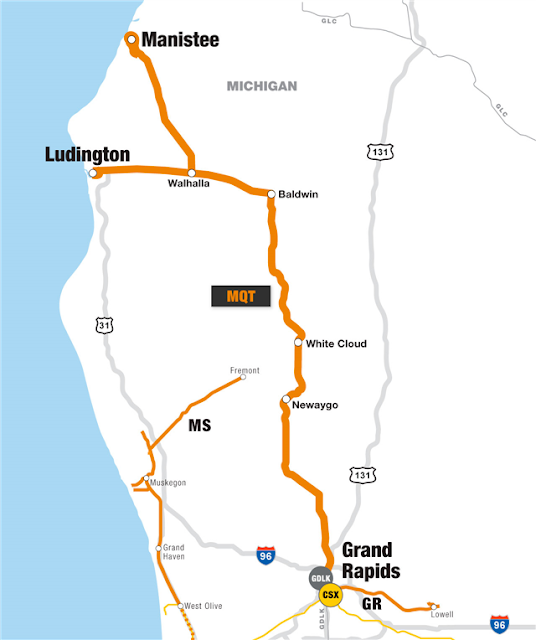"Along with the few other truss bridges in the Grand Rapids area, the bridge is among the longest truss bridges in Michigan. Very few rivers in Michigan reach the size of the Grand River in this area." Originally, the bridge carried two tracks. [Historic Bridges]
 |
| Street View |
 |
| Photo taken by Brent Tindall in Apr 2014 via Bridge Hunter, License: Released into public domain Upstream side from West end [The first span was completed in 1922 and the next span was one of the original spans and it was built in 1901. We can barely see the tie rods in the pin-connected Pratt Truss of the second span. The Warren Truss span is old enough that it is still using V-lattice for the compression members.] |
 |
| Brian Caswell posted MQT 3389 (Z151) Leads a four unit short manifest North over the Grand River in downtown Grand Rapids Michigan , on its way North to Grant / 12-29-20 Tim Shannahan shared Theodore Garofolo: Does the swing still open? Tim Shannahan: Theodore Garofolo Nope. Theodore Garofolo The requirement to accommodate navigation on the Grand River was dropped in 1907, just four years after the bridge was finished! |
 |
| Dennis DeBruler commented on Tim's share MQT is Marquette Rail that operates former Pere Marquette routes. |
 |
| Satellite plus Paint The date information comes from Historic Bridges. I think Bridge Hunter has the 1908 and 1922 spans reversed. |
 |
| Jonathon Leese posted NS job B49, running as Z739 on CSX, crosses the Grand River northbound with a former Conrail GP40-2 and GP38-2 for power. On the head end of the train are gondolas full of wire for Michigan Wire in Lowell on the Grand Rapids Eastern, which burned down a few years later. Norfolk Southern's presence in Grand Rapids would disappear 2 years later when they leased their line to Watco's Grand Elk. Grand Rapids 3/29/07 Roger Riblett posted |
Historic Bridges observes that the original spans do not have overhead lateral bracing, only portal bracing and struts (sway bracing). The satellite image and the following photo teach me that "lateral bracing" must mean the diagonal members in the top chord.
 |
| Photo taken by Brent Tindall in Apr 2014 via Bridge Hunter, License: Released into public domain Looking Southeast |
Historic Bridges also explains: "At first glance, the 1908 fixed span also appears identical to the 1901 fixed span. However a few minor detail differences are present. The 1901 span features vertical members with v-lacing that is a heavy-duty style common on railroad bridges where each lacing bar has no rounded ends, each end of the bar is fastened with two rivets, and lacing bars do not overlap. The 1908 span in contrast has v-lacing style that was used frequently on both highway and railroad bridges. These lacing bars feature rounded ends with a single rivet at each end, and the ends of the lacing bars overlap with their neighbor, sharing each rivet. Also, the 1908 span has overhead lateral bracing, giving it a more traditional appearance." None of Brent's photos have enough detail to show the lacing in the older spans. But it is easy to see that the 1922 span uses the "heavy-duty style" of lacing.
 |
| An excerpt from the above photo at photo resolution |
As an example of the other style of lacing, here is one of my detail photos of the 1880s Old Renwick Road Truss Bridge that shows a single rivet through the ends of rounded lattice bars.
 |
| 20200317 1644 |

No comments:
Post a Comment